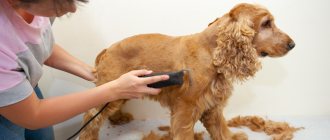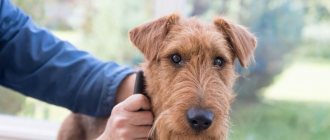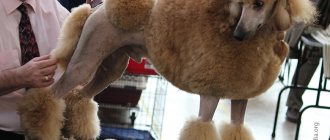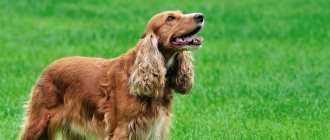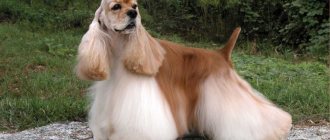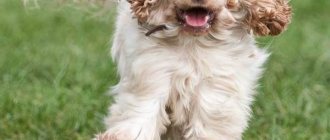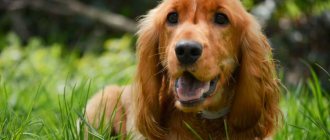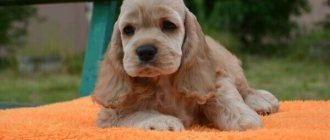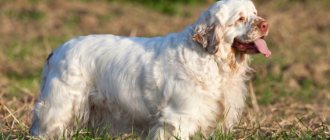Long, silky, slightly curly coat that flows downward in waves is the calling card of the Cocker Spaniel breed. The dog usually captivates everyone with its delightful appearance, and only its owner knows that regular careful care is behind this.
Bathing, combing and the obligatory haircut of a cocker spaniel are the most important conditions for the proper maintenance of a pet. And in order not to spend money on a grooming salon, we’ll figure out how to tidy up a dog’s fur at home.
General rules
Maintaining the wavy coat of a Cocker Spaniel is quite difficult. However, this must be done. The spaniel is trimmed not only for aesthetic purposes, but also for hygienic purposes.
Even if you do not plan to exhibit your dog in competitions and exhibitions, you should definitely groom your pet regularly in a salon or on your own at home.
Among the many subspecies of the breed, the following spaniels are widespread in Russia:
- English cocker;
- American cocker;
- Russian cocker.
For each of them there are certain standards and requirements for grooming. However, there are basic rules provided for by the breed standards:
- the hair on the face, head and neck is short;
- natural length hair on the shoulders and back;
- the ears, belly, paws and tail have longer hair;
- Excessive curliness and thickness of the coat is removed a little, leaving curls on the bottom of the ears.
The coat of dogs of this breed grows quite quickly. An overgrown cocker looks unaesthetic and sloppy. The correct haircut will always highlight the beauty, elegance and dignity of the spaniel.
Photo gallery
Haircut standards are shown in the photo:
American black cocker spaniel
English red cocker spaniel
English black cocker spaniel
Haircut at home or at a specialist
You can have your cocker spaniel cut by a professional groomer. This has its advantages:
- compliance with hygiene conditions;
- availability of necessary equipment;
- the behavior of an animal in a salon without an owner is more balanced;
- the owner has free time during the procedure.
It is possible to style your four-legged pet's hair at home. However, the owner who decides to carry out the procedure on his own must adhere to certain haircut rules and become familiar with its nuances.
In order not to disfigure your spaniel, it is better to visit the hairdresser several times and get a master class from a knowledgeable specialist.
Preparation for the exhibition
Show animals are groomed once a month. If you are going to participate in an exhibition, the procedure is carried out approximately three days before the date. As a rule, preparation is entrusted to a professional master.
It is advisable to make a trial, draft version two to three weeks before the exhibition haircut. This will allow you to evaluate the result of the work and correct shortcomings (cut off excess, grow excessively shortened areas). Before the ring, the coat is combed and trimmed if necessary.
Spaniel puppies are amazingly cute. It is impossible to look at these pets without smiling. The main difference is the curly, silky coat, which makes you pet your little friend without interruption. The spaniel's haircut can be different. The owner has the choice of classic or creative options.
When do you get your first haircut?
The first acquaintance of a small cocker with scissors and a clipper should occur no later than 2 months of age. If this is delayed, then grooming an older spaniel can turn into real stress for the animal.
A familiar home environment will help the puppy cope with the first grooming procedure more easily. Therefore, to begin with, it is recommended to invite a professional hairdresser to your home. However, it is better for the owner himself to leave the room. Then the pet will behave more calmly.
The first sessions should not be long. A short hygiene procedure is sufficient. The groomer must be able to find an approach to the animal, treat the puppy kindly and as friendly as possible. After all, the dog’s further attitude towards the important grooming procedure depends on how the first grooming session goes.
Mating
- Upon reaching 8-9 months, representatives of this breed enter sexual maturity, but they are ready for mating after the body has fully matured. Males reach puberty at 8-10 months. But this moment is individual for each dog.
- An experienced and active bitch is selected for a young male. A dog's breeding career largely depends on the first time.
- The female is ready for mating on the 11-13th day of estrus, but before the procedure the animals must be vaccinated. Before mating, the pets are prepared and introduced so that they feel confident. After getting to know each other, they bring the animals together and help them mate. To do this, experienced breeders keep the female, the owner can hold the cable.
How often should you cut your hair?
Until the puppy is six months old, it is advisable to cut it more often. Then the animal will quickly get used to the procedure and will perceive it calmly and without whims. Next, it is recommended to trim as the coat grows.
It is better to visit a dog groomer every 2-3 months. However, the frequency of haircuts for cockers depends on the individual characteristics of each dog and the breed variety.
Vaccination
Russian spaniels, like other representatives of hunting breeds, often come into contact with wild animals. Therefore, an important point in the care and maintenance of a dog is timely vaccination. In the first year of life, this procedure takes place in several stages. Deworming is carried out 7–10 days before each vaccination.
The first vaccinations for Russian Spaniel puppies are given at 6–10 weeks, followed by booster vaccinations at 10–14 weeks. Typically, a complex vaccine is used for this, which will protect the animal from canine distemper, leptospirosis and other infections.
Rabies vaccination is also mandatory - it is given no earlier than 10-14 weeks. 2 weeks after the last vaccination, the puppy can go for its first walk.
Starting from 12 months, the animal must be revaccinated annually with a complex vaccine against rabies and other infections. Before this procedure, the adult dog is also dewormed.
In addition, for some time after vaccination, the Russian Spaniel must be provided with special care: do not wet the injection site for 2-3 days, and completely bathe the animal no earlier than after 10 days. Also during this time you need to carefully monitor your pet: do not allow him to get wet or hypothermia.
What types of haircuts are there?
Cockers get two types of haircuts. It depends on whether the spaniel participates in exhibitions and shows. If the owner does not intend to take the pet to competitions, then a hygiene procedure that can be carried out independently will be sufficient.
Hygienic
It is based on the removal of excess hair, which gives the animal a more well-groomed appearance. Typically, a hygienic or partial haircut of a cocker spaniel consists of several stages:
- The hair inside the ears is shortened, the hair on the paws is trimmed between the toes.
- Excess hair is removed from the belly, groin and under the tail.
- At the end of the procedure, the spaniel is thoroughly combed so that no mats of wool remain.
The procedure is quite simple and can be done by the owner himself, if he is not new to the art of dog grooming.
Exhibition
For the exhibition (full) procedure the following steps are required:
- Use a brush to completely comb the animal.
- Run a fine-toothed comb over the body.
- Comb long hair with a wide-tooth comb.
- Trim your pet's back and sides.
- Trim your ears inside and out with a clipper.
- Remove hair from between toes using round scissors.
- Bathe your pet, dry it and comb it.
Exhibition grooming of a cocker spaniel depends on the dog's belonging to a particular species. For each of them there are certain standards that the pet must meet.
Russian cocker spaniel
The Russian Cocker Spaniel is used not only as a domestic dog, but also as a hunting assistant. Therefore, his appearance must be both beautiful and reasonable.
The main requirement for the appearance of a Russian Spaniel is maximum naturalness without a hint of artificial interference with natural attractiveness. Therefore, such a dog is cut only in the groin area and under the tail. Use scissors to remove stray hairs on the tail without changing its length. The fluff is plucked out. Brush the cocker with a fine-toothed comb until the coat becomes straight.
The haircut is usually carried out 2-3 weeks before the exhibition, so that the groomer’s efforts are not so noticeable and the spaniel’s score is not lowered.
American Cocker Spaniel
The American Cocker, unlike the Russian, plays the role of a companion and decorative pet. This breed has not been involved in hunting for a long time. “American” haircuts are somewhat different:
- The head, neck, chin, eyebrows are cut short with a clipper.
- The silky, soft fur on the back is not touched, but only combed so that it fits snugly to the body.
- The fluffy hair on the paws and lower part of the body fits into a kind of “skirt”, the lower edge of which should be smooth.
- The density of the wool is removed by thinning.
- The transition from the back to the “skirt” should be smooth and unnoticeable.
- A sparse comb is used for combing.
All lines of the American Show Cocker Spaniel's silhouette should be natural. Only in this case is success at the competition guaranteed.
English cocker spaniel
The English Cocker Spaniel's haircut is also characterized by certain nuances:
- The head is short-cropped, without bangs. It is performed using a machine in the direction from the forehead to the nose against the hair.
- The ears should be teardrop shaped.
- A triangle of long hair remains on the chest of the English cocker.
- The top of the back along the spine is plucked.
- Long hair remains on the sides.
- The front legs are short-haired in front and on the sides, and long-haired in the back.
- The hind legs of the English Cocker are cut only from below to the joint, and the length is left on top of the hips.
Interesting to know! When cutting black English spaniels, thinning scissors are used on the sides. And for an English dog of brown or red color, trimming is used.
Marks after the main haircut must be smoothed out. A show English Spaniel should look elegant and stylish.
English
The haircut involves smooth short hair without bangs on the head. The mustache, beard and bangs are cut with thinning scissors. Particularly short hair is left on the cheeks. The ears are trimmed with scissors to the required length. Milled if desired.
The chest is cut short with a clipper in the direction of hair growth. A trimming knife is used on the back. This way it will look even and smooth, with a slight bulge. The black cocker is filleted from the sides, the red cocker is trimmed. The pile on the croup is only trimmed. A quadrangle is trimmed in the anal area. Traces of trimming or cutting are smoothed out with scissors.
Long hair is left on the thighs of the hind legs up to the hock joint. From the joint to the paw - shorten. In front, on the sides of the forelimbs, the hair is shortened, in the back it is left long. In places where the hair is shortened, the hair is trimmed, the tows are cut at an angle of 30 degrees.
Types of haircuts for puppies girls and boys
English Cocker Spaniels of different sexes are cut differently. For energetic and playful spaniel boys use:
- Like a poodle. This is a type of short haircut where the fur on the animal's body is cut short. What remains is a small “cap” on the head and fluffy ears. On the animal's limbs, the fur should be the same length on all sides. So the cocker's paws resemble those of a poodle.
- Stripping (hair plucked by hand) with a short “skirt”. The dog's neck, head and body are stripped. On the ears, the hair is shortened with scissors almost to the edge. Small fringes remain on the paws. The haircut on the stomach is quite short, but there is still a certain length left for the “skirt”.
For English spaniel girls, who are calm and more affectionate, other types of haircuts are used:
- Trimming (hair is plucked with a special tool) with a long “skirt”. The coat is kept to maximum length underneath throughout the body, and the shoulders and back are trimmed to remove any stray hairs. The silhouette of the dog is correct and beautiful.
- Trimming with a medium "skirt". In this version, the “skirt” is shortened by almost half. Exterior features are preserved, and the pet looks well-groomed and tidy.
Should be considered! The listed types of model grooming should be used if the English Cocker Spaniel is not going to compete for the title of champion at exhibitions.
Content
The Russian Spaniel is unpretentious in its maintenance. You need to determine a place for it in an apartment or house. It should not be in a dark corner, in a draft, near the entrance door, or near radiators. The bathroom and kitchen are also not suitable. A dog should sleep only in the place assigned to it. Don't forget about regular cleaning.
As a bed, you can use a basket with low sides, a wooden box or a textile mat. Consider the size of the animal. The dog should fit there calmly in any position.
In spring and autumn, spaniels begin to shed. If the air in the room is dry, it will be more noticeable.
Some owners tend to believe that keeping a spaniel in an apartment is unacceptable. This weakens its performance, turning the pet into a decorative dog. The Russian spaniel is, first of all, a hunting breed. He has a dense, thick undercoat. It is adapted to any weather conditions. Therefore, keeping him outside is perfect for him. There is somewhere to roam and something to chew, you can throw out all your energy.
Of course, it is better if the booth in the enclosure is insulated. This will avoid diseases during the cold season and protect the dog from rain and wind. It is better to choose a dry place, on a hill, at a distance of 10-15 meters from residential premises. Preferably in the shade of trees.
Do not keep your dog in a closed barn or near other animals: sheep, goats, etc.
What you need for a haircut
To groom a cocker spaniel, you need to stock up on a certain set of tools and equipment:
- table, preferably with adjustable height;
- dog clipper with various attachments;
- straight and thinning scissors;
- trimming knife;
- combing brush;
- combs (with rare and frequent teeth);
- hair dryer for drying wool after bathing;
- rubber mat for the cocker spaniel's comfort during the procedure.
If your pet tries to run away or spins around, you can use a leash, but it is better not to do this. If the fidget is too excited, you should postpone the haircut session. Otherwise, there is a danger of injuring the animal.
Dog grooming
Professional comprehensive care (or grooming) is carried out in specialized salons by specially trained people.
The scheme includes the following procedures:
- disinfectant wash;
- combing;
- trimming fur;
- trimming;
- washing and cleaning ears;
- special dog “manicure”;
- washing eyes;
- teeth cleaning;
- prevention of all kinds of parasites.
Please note that spaniels should only be bathed in warm water using shampoo intended for dogs with long hair. Professional groomers also use tinting agents to give texture to the coat.
It is not allowed to use regular shampoo to wash dogs, as it dries and irritates the animal's skin.
During washing, water should not get into the ears. Specialists are well aware of this, at first glance, easy rule, and also notice any problem areas on the pet’s skin. Owners should be very careful and master the tricks of care. If you have doubts about your abilities, it is better to turn to professionals.
How to cut your hair at home: step-by-step instructions
Grooming a cocker spaniel at home is carried out in a certain sequence of actions:
- The wool must be thoroughly combed, removing all tangles. The Cocker Spaniel is bathed and dried with a hairdryer. It is recommended to use a special device for animals with a hot air regulator. Comb again with a fine-toothed comb.
- Unnecessary hair length is removed with a machine. Straighten with thinning scissors. This is done so that there are no sharp transitions in the length of the coat. The cut hairs are combed with a massage brush.
- The spaniel's head and cheeks are carefully trimmed and milled.
- The ears are shaved inside and out with a machine. The bottom of the ears remains fluffy.
- In the neck area, hair is removed with a machine, and on the chest, a length in the shape of a triangle is left.
- The back is processed from head to tail using a trimming knife.
- The sides are cut with a clipper solely according to hair growth.
- The hair on the paws between the toes is cut just above the claws. Otherwise, dirt sticks to the paws and bothers the animal.
- The tail is trimmed with a clipper, but this is not necessary.
- The area under the tail is processed with small scissors.
It is recommended to carry out the procedure in good lighting in a calm environment. The owner should not rush or be nervous. The hairdresser’s positive attitude will be transferred to the animal, and the home grooming session will take place without “surprises”.
How to care for claws
You can use a nail clipper or nail clippers to trim the nails. Taking the animal's paw in your hand, spread your fingers and carefully trim the claws parallel to the pads.
Do not cut very deeply, otherwise you may injure your pet. Next, you need to file the trimmed claws with a nail file.
Worth knowing! If bleeding occurs while trimming the nails, you should stop the session and stop the bleeding. It is better to wash the paw and treat it with a solution of hydrogen peroxide.
English Cocker Spaniel training
Hunting with an English Cocker Spaniel
In modern conditions, the “English” are gradually changing their qualifications, increasingly turning into sporting dogs and playful companions. However, the hunting instincts of the breed do not suffer from this situation. English cocker spaniels can work with both swamp and field or even upland game. However, taking into account the fact that each type of bird has its own odor, varying in intensity, it is unlikely to be possible to train a dog on both snipe and black grouse at once. Experienced owners recommend starting to introduce your pet to hunting with a wading bird. According to observations, a dog that deftly handles great snipes performs just as well when working with quails. At the same time, dogs, accustomed to lifting only wild animals onto their wings, slow down and get lost in wetlands.
The English Cocker Spaniel begins to be trained from an early age and in a playful way. For example, you can tie a bird's wing to a string and twitch it in front of a 3-month-old puppy's nose. The surprised animal will immediately try to grab the animated bunch of feathers, and your task is to allow him to do this. Just do not allow the puppy to chew the “prey”, since this habit will later be transferred to real hunting trophies. At 4 months, babies are trained to search for and present objects. The dog is allowed to sniff the bird carcass, after which they hide it in a secluded place and offer to find the missing one. At first, you can use hints - a hand gesture in the direction of an object or a deliberately created draft that carries the smell of game throughout the apartment.
Commands “Come to me!” and “Nearby!” in hunting dogs they must be practiced to the point of automatism, therefore the OKD completed before training is only beneficial for the English cocker. Another important skill is indifference to shots, which is the most difficult for the “English”. They begin to accustom their pet to the sharp sounds and smell of gunpowder in the field. First, shots are fired at a distance (the optimal distance is 150 m) and only after the dog gets used to the noise, the gap between the shooter and the animal is gradually reduced.
Important: in order to develop a clear understanding of your requirements and compliance in your English Cocker Spaniel, use only one prohibitive command out of several possible ones. Do not disorient the dog with the word “Ugh!” If before that he only heard from you “No!”
It is better to start getting acquainted with swamp game with great snipes, which fly quite low and heavily. Swamp hens are also a good target for an inexperienced cocker. In upland hunting, the optimal target will be a brood of grouse. As a rule, English cocker spaniels are not involved in working with waterfowl, but if you wish, it is also possible to train your pet for this type of game. Wait until mid-July, when the ducklings are grown but not fully fledged, and begin training. Well, an option for the most seasoned is hare hunting. Why specifically for the aged? Because spaniels love to chase their long-eared dogs aimlessly, in 99% of cases leaving the owner without prey.
Hair care tips
When caring for your pet's fur, you should follow the following basic rules:
- Regular brushing removes loose old hair and prevents tangles. It is necessary to comb your cocker every day, accustoming him to the procedure from puppyhood. A massage brush is used for the abdomen, and a comb is used for the back and sides.
- Bathing the animal. Water treatments are recommended for a cocker spaniel 3-4 times a month. The water should not be too hot. When choosing a detergent for your cocker, it is best to consult a veterinarian or groomer. It is usually recommended to use a special mild shampoo for long-haired pets. It is important to ensure that the dog wash does not dry out the skin.
- Grooming is highly recommended for all cockers. A properly and neatly trimmed dog looks presentable and well-groomed. In addition, with its long coat, a spaniel can spread all kinds of rubbish, dust and even parasite larvae throughout the house. All this can be avoided by giving your cocker a proper haircut on time.
- Regular straightening of the hair on the spaniel's ears and paws. It is better to learn this procedure from a professional groomer.
If you take care of your cocker spaniel's coat, your pet will be healthy, beautiful and impressive. In addition, having learned how to properly cut the hair of his shaggy friend, the owner of a cocker will be able to show off his hairdressing skills to his fellow dog lovers.
Miniature hunting breed dwarf cocker spaniel: pet character traits
Spaniels are hunting dogs bred to hunt small game. They are completely non-aggressive towards people and get along well with children. One of the most common breeds today is the dwarf cocker spaniel, which was developed relatively recently.
Origin
Spaniels are one of the ancient dog breeds, known since the Middle Ages. So, there is a legend about the Spanish crusaders who used these dogs for hunting, and some sources indicate that dogs similar to spaniels existed in ancient Rome. Presumably, this is when the breed got its name (from Spania - Spain).
The breed was first mentioned in documents in the 14th century in the work of G. Phebus, who was engaged in describing the fighting and hunting breeds of dogs that existed at that time. In the 17th-18th centuries, the breed spread throughout Western Europe and was divided into several varieties.
In the 19th century, the cocker spaniel breed appeared, which, as a result of intensive selection, was also divided into several breeds, incl. English Cocker Spaniel, from which a dwarf variety was bred already in the 20th century. The breed appeared in Russia only in the 70s of the 20th century.
Ear diseases
The ears are the most vulnerable place of all spaniels, without exception. They are usually due to the fact that the dog’s ears are poorly ventilated, which creates favorable conditions in the shell and ear canal for the development of fungal and bacterial infections.
The first sign of the disease is itching, due to which the dog begins to actively itch, cannot find a place for itself, and may whine. Then the itching is accompanied by discharge (purulent or serous), and a cloying odor.
With inflammation of the middle and inner ear, problems with coordination of movements and maintaining balance may also occur; the dog may stumble when walking or walk in circles. Most often, spaniels suffer from otitis media of various etiologies. In this case, an undoubted advantage is the inaccessibility of the ears to foreign objects.
Another vulnerable spot of the spaniel is the respiratory tract. During the cold season, dogs of this breed easily catch colds, getting bronchitis, pneumonia, etc. diseases.
Eyes
Spaniels need regular (preferably daily) eye care. Mucus and dust accumulate in the corners of the eyes, which must be removed, otherwise conjunctivitis develops quite quickly. To care for your eyes, you can use either a dry cotton swab or a swab moistened with a solution of boric acid. There are also special wipes for the eyes.
Metabolism and digestion
In order for your pet to remain healthy and active, it should be fed to its fullest without fear of obesity. It is advisable that the diet include dry food.
Metabolism in these dogs is quite active, so the dog needs regular exercise.
You need to walk with your spaniel for at least two hours every day, from time to time the pet must run, swim, play with various objects, etc. Otherwise, these dogs develop physical inactivity.
Care
In addition to eye care and daily walks, the dog needs to comb its coat, trim its nails and brush its teeth.
Swimming in warm water is also very useful and pleasant for a spaniel, especially after a walk. To avoid allergies and skin diseases, you should use only high-quality shampoos for dogs, and in no case resort to “human” products or laundry soap.
Most reviews about the breed are positive; in negative reviews, dog breeders point out how sick their pets are.
- “A very kind plush dog, the life of the party. Not aggressive at all. A little prone to begging. At the same time, a devoted friend who can always cheer you up.”
- “The dog is very kind and obedient, he lived with us for 12 years, during which time there were no problems with him.”
- “A good, but sickly breed... We were warned about diseases of the lungs and ears, but our dog died of a tumor.”
Price
The cost of puppies varies depending on the region and who is selling them. Thus, nurseries usually sell small spaniels for 15-30 thousand rubles, while from amateur dog breeders you can buy an animal for 5-10 thousand. At the same time, it should be taken into account that dogs from the kennel already have the necessary vaccinations, documents, etc.
Conclusion
The Miniature Cocker Spaniel is the smallest of the hunting dogs, which has the typical features of a spaniel and is perfect for living with a lot of people, with children, with cats, etc. The dog is active, friendly, but needs care and is often sick.
